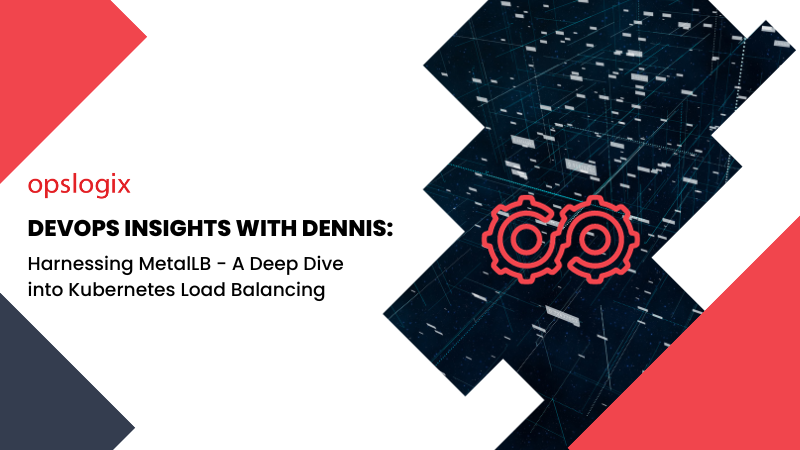Harnessing MetalLB - A Deep Dive into Kubernetes Load Balancing
by Dennis Tyresson, on Oct 9, 2024 2:19:51 PM

DevOps Insights with Dennis
Did you know about the Opslogix DevOps Upskill Program? Through the program, skillful IT consultants improve their DevOps knowledge through a combination of theoretical and practical training.
In this blog series, our DevOps consultant Dennis will share some of the insights he has gained through the program. This is the third blog post in the series, click here to read the first post about Kubernetes cluster orchestration with Ansible and Terraform on Proxmox VE, and here to read the second post about GitOps - the way of the Kubernetes professional.
In this blog post, you will learn more about Dennis' insights on Harnessing MetalLB - A Deep Dive into Kubernetes Load Balancing.
Introduction
In the seamless realm of public clouds, load balancing for Kubernetes clusters is often a built-in luxury. However, in private Kubernetes clusters, this functionality is not automatic, necessitating manual implementation. Tools to enable load balancing become vital for administrators to bridge the gap, ensuring efficient traffic distribution and high availability in private cloud environments.
MetalLB, an open-source solution purpose-built for Kubernetes, emerges as a powerful tool to address this critical need. This technical blog post aims to provide a comprehensive guide on leveraging MetalLB as a load balancer for a Kubernetes cluster.
Understanding MetalLB
Architecture overview
MetalLB operates at the network layer, presenting a Layer 2 or BGP-based solution for distributing external traffic among Kubernetes services. In Layer 2 mode, MetalLB assumes a virtual router role, handling ARP requests and directing traffic to the appropriate pods. Alternatively, in BGP mode, it dynamically advertises service IPs to external routers, seamlessly integrating with existing network infrastructures.
Integration with Kubernetes Services
MetalLB extends Kubernetes' native Service type LoadBalancer. When a service of this type is defined, MetalLB dynamically allocates an external IP address and efficiently routes traffic to the corresponding pods within the cluster. This integration simplifies load balancing configuration and aligns with Kubernetes conventions.
Deploying MetalLB
Prerequisites
Before diving into MetalLB deployment, ensure that you have a running Kubernetes cluster and the requisite permissions to install and configure resources.
Installation
Deploying MetalLB involves applying its Kubernetes manifests or utilizing Helm charts. The official documentation provides detailed instructions for both methods. Below is a brief overview of the manifest-based installation:
# Apply the MetalLB manifest
kubectl apply -f https://raw.githubusercontent.com/metallb/metallb/v0.13.12/config/manifests/metallb-native.yaml
Configuration
MetalLB's flexibility lies in its configuration options. A ConfigMap defines the IP address range MetalLB can allocate from and other parameters. Below is a basic example of a MetalLB ConfigMap:
apiVersion: metallb.io/v1beta1
kind: IPAddressPool
metadata:
name: first-pool
namespace: metallb-system
spec:
addresses:
- 192.168.1.240-192.168.1.250In this example, MetalLB is configured to allocate IPs from the specified range in Layer 2 mode.
In addition to an IP pool, we also need a L2Advertisement instance associated with the same pool.
apiVersion: metallb.io/v1beta1
kind: L2Advertisement
metadata:
name: example
namespace: metallb-system
spec:
ipAddressPools:
- first-poolIn the example above, the L2Advertisement is associated to the pool 'first-pool'. If the spec property is omitted, then the instance will be associated to all available pools.
Deploying Services with MetalLB
With MetalLB in place, creating a load-balanced service is straightforward. Simply define a service with the type LoadBalancer and let MetalLB handle the rest:
apiVersion: v1
kind: Service
metadata:
name: nginx
annotations:
metallb.universe.tf/address-pool: first-pool
spec:
ports:
- port: 80
targetPort: 80
selector:
app: nginx
type: LoadBalancerUpon creating this service, MetalLB allocates the specified external IP and directs traffic to the corresponding pods.
Monitoring and Troubleshooting
MetalLB provides logs and metrics for monitoring its operation. Regularly reviewing these insights aids in troubleshooting and optimizing performance. Refer to the official documentation for details on accessing logs and metrics.
Conclusion
MetalLB empowers Kubernetes administrators with a robust and flexible load-balancing solution.
By seamlessly integrating into the Kubernetes ecosystem and offering configuration options tailored to specific requirements, MetalLB stands as a valuable tool for enhancing the resilience and efficiency of containerized applications.
Implementing MetalLB as a load balancer not only simplifies traffic distribution but also contributes to a more reliable and performant Kubernetes environment.
Do you want to learn more about the Opslogix DevOps Upskill Program?



